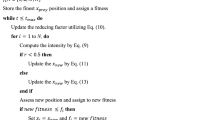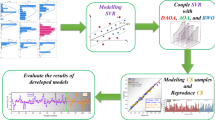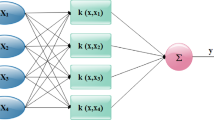Abstract
Ultra-high-performance concrete (UHPC), with the highest resistance capacity against axial loads, is composed of various ingredients compared to other typical concretes, including fly ash and silica fume; eco-friendly materials also have an economical price. Such high-resistant constructional materials are seen as a suitable aggregate to use in most practical projects. The compressive strength (CS) of concrete, as one of the important variables in engineering fields, can be estimated using smart approaches based on ingredients as inputs fed to the mathematical model. Consequently, the current study modeled the CS values using a machine learning technique of Support vector regression (SVR) accompanied by the grasshopper optimization algorithm (GOA) and arithmetic optimization algorithm (AOA), tunning the SVR to appraise the CS accurately. In developing AOA-SVR and GOA-SVR frameworks, several metrics were used to assess the ability and accuracy of models. As a result of the present study, it can be concluded that the machine learning method in hybrid form has the ability to predict for saving time and energy. In general, in comparing the results of hybrid models, AOA had the most suitable combination with SVR compared to GOA, with R2 = 0.901 and RMSE = 9.986 in the training phase. In addition, AOA-SVR improved its performance by R2 = 0.917 and RMSE = 9.525 in the test phase.







Similar content being viewed by others
References
Abd AM, Abd SM (2017) Modelling the strength of lightweight foamed concrete using support vector machine (SVM). Case Stud Constr Mater 6:8–15. https://doi.org/10.1016/j.cscm.2016.11.002
Abualigah L, Diabat A, Mirjalili S, Abd Elaziz M, Gandomi AH (2021) The arithmetic optimization algorithm. Comput Methods Appl Mech Eng 376:113609. https://doi.org/10.1016/j.cma.2020.113609
Abualigah L, Almotairi KH, Elaziz MA, Shehab M, Altalhi M (2022) Enhanced flow direction arithmetic optimization algorithm for mathematical optimization problems with applications of data clustering. Eng Anal Bound Elem 138:13–29. https://doi.org/10.1016/j.enganabound.2022.01.014
Abuodeh OR, Abdalla JA, Hawileh RA (2020) Assessment of compressive strength of ultra-high performance concrete using deep machine learning techniques. Appl Soft Comput 95:106552
Agushaka JO, Ezugwu AE (2021) Advanced arithmetic optimization algorithm for solving mechanical engineering design problems. PLoS ONE 16(8):e0255703. https://doi.org/10.1371/journal.pone.0255703
Alakbari FS et al (2023) Prediction of critical total drawdown in sand production from gas wells: machine learning approach. Can J Chem Eng 101(5):2493–2509
Alakbari FS, Elkatatny S, Baarimah SO (2016) Prediction of bubble point pressure using artificial intelligence AI techniques. In: SPE middle east artificial lift conference and exhibition
Al-Fugara A, Ahmadlou M, Al-Shabeeb AR, AlAyyash S, Al-Amoush H, Al-Adamat R (2020) Spatial mapping of groundwater springs potentiality using grid search-based and genetic algorithm-based support vector regression. Geocarto Int 37(1):284–303. https://doi.org/10.1080/10106049.2020.1716396
Alkaysi M, El-Tawil S (2016) Effects of variations in the mix constituents of ultra high performance concrete (UHPC) on cost and performance. Mater Struct 49(10):4185–4200
Armaghani DJ, Asteris PG (2021) A comparative study of ANN and ANFIS models for the prediction of cement-based mortar materials compressive strength. Neural Comput Appl 33(9):4501–4532
Ayoub MA, Elhadi A, Fatherlhman D, Saleh MO, Alakbari FS, Mohyaldinn ME (2022) A new correlation for accurate prediction of oil formation volume factor at the bubble point pressure using group method of data handling approach. J Pet Sci Eng 208:109410
Ayoub Mohammed MA, Alakbari FS, Nathan CP, Mohyaldinn ME (2022) Determination of the gas-oil ratio below the bubble point pressure using the adaptive neuro-fuzzy inference system (ANFIS). ACS Omega 7(23):19735–19742
Azimi-Pour M, Eskandari-Naddaf H, Pakzad A (2020) Linear and non-linear SVM prediction for fresh properties and compressive strength of high volume fly ash self-compacting concrete. Constr Build Mater 230:117021. https://doi.org/10.1016/j.conbuildmat.2019.117021
Baarimah SO, Baarimah AO (2021) PVT properties for yemeni reservoirs using an intelligent approach. In: 2021 third international sustainability and resilience conference: climate change, pp 368–372
Baarimah SO, Al-Gathe AA, Baarimah AO (2022) Modeling yemeni crude oil reservoir fluid properties using different fuzzy methods. In: 2022 international conference on data analytics for business and industry (ICDABI), pp 761–765
Chen B-T, Chang T-P, Shih J-Y, Wang J-J (2009) Estimation of exposed temperature for fire-damaged concrete using support vector machine. Comput Mater Sci 44(3):913–920
Cheng M-Y, Prayogo D, Wu Y-W (2014) Novel genetic algorithm-based evolutionary support vector machine for optimizing high-performance concrete mixture. J Comput Civ Eng 28(4):6014003
Chou J-S, Pham A-D (2015) Smart artificial firefly colony algorithm-based support vector regression for enhanced forecasting in civil engineering. Comput Civ Infrastruct Eng 30(9):715–732. https://doi.org/10.1111/mice.12121
Cortes C, Vapnik V (1995a) Support-vector networks. Mach Learn 20(3):273–297
Cortes C, Vapnik V (1995b) Support-vector networks. Mach Learn 20(3):273–297
Gholampour A, Mansouri I, Kisi O, Ozbakkaloglu T (2020) Evaluation of mechanical properties of concretes containing coarse recycled concrete aggregates using multivariate adaptive regression splines (MARS), M5 model tree (M5Tree), and least squares support vector regression (LSSVR) models. Neural Comput Appl 32(1):295–308. https://doi.org/10.1007/s00521-018-3630-y
Graybeal BA (2006) Material property characterization of ultra-high performance concrete. United States Federal Highway Administration, Office of Infrastructure, Washington
Hadi MNS (2003) Neural networks applications in concrete structures. Comput Struct 81(6):373–381
Kasperkiewicz J, Racz J, Dubrawski A (1995) HPC strength prediction using artificial neural network. J Comput Civ Eng 9(4):279–284. https://doi.org/10.1061/(ASCE)0887-3801(1995)9:4(279)
Khatir S, Tiachacht S, Le Thanh C, Ghandourah E, Mirjalili S, Abdel Wahab M (2021) An improved artificial neural network using arithmetic optimization algorithm for damage assessment in FGM composite plates. Compos Struct 273:114287. https://doi.org/10.1016/j.compstruct.2021.114287
Ling H, Qian C, Kang W, Liang C, Chen H (2019) Combination of support vector machine and K-fold cross validation to predict compressive strength of concrete in marine environment. Constr Build Mater 206:355–363
Lute V, Upadhyay A, Singh KK (2009) Support vector machine based aerodynamic analysis of cable stayed bridges. Adv Eng Softw 40(9):830–835
Masoumi F, Najjar-Ghabel S, Safarzadeh A, Sadaghat B (2020) Automatic calibration of the groundwater simulation model with high parameter dimensionality using sequential uncertainty fitting approach. Water Supply 20(8):3487–3501. https://doi.org/10.2166/ws.2020.241
Medellín-Azuara J et al (2015) Hydro-economic analysis of groundwater pumping for irrigated agriculture in California’s Central Valley, USA. Hydrogeol J 23(6):1205–1216
Meng W, Valipour M, Khayat KH (2017) Optimization and performance of cost-effective ultra-high performance concrete. Mater Struct 50(1):1–16
Mirjalili S (2015) The ant lion optimizer. Adv Eng Softw 83:80–98
Mohamad Ali Ridho BKA, Ngamkhanong C, Wu Y, Kaewunruen S (2021) Recycled aggregates concrete compressive strength prediction using artificial neural networks (ANNs). Infrastructures 6(2):17. https://doi.org/10.3390/infrastructures6020017
Pal M, Deswal S (2011) Support vector regression based shear strength modelling of deep beams. Comput Struct 89(13–14):1430–1439
Park JY, Yoon YG, Oh TK (2019) Prediction of concrete strength with P-, S-, R-wave velocities by support vector machine (SVM) and artificial neural network (ANN). Appl Sci 9(19):4053
Rajasekaran S, Gayathri S, Lee T-L (2008) Support vector regression methodology for storm surge predictions. Ocean Eng 35(16):1578–1587
Resplendino J, Toulemonde F (2013) Designing and building with UHPFRC. Wiley, New York
Richard P, Cheyrezy M (1995) Composition of reactive powder concretes. Cem Concr Res 25(7):1501–1511
Samui P (2012) Application of statistical learning algorithms to ultimate bearing capacity of shallow foundation on cohesionless soil. Int J Numer Anal Methods Geomech 36(1):100–110
Saremi S, Mirjalili S, Lewis A (2017) Grasshopper optimisation algorithm: theory and application. Adv Eng Softw 105:30–47. https://doi.org/10.1016/j.advengsoft.2017.01.004
Schmidt-Döhl FM, Schmidt H, Franke L, Deckelmann G (2017) Limiting concentrations for ultra high strength concrete in contact with aggressive solutions. In: 11th HPC conference 2017, Tromsø, Norway
Shariati M et al (2020) A novel hybrid extreme learning machine-grey wolf optimizer (ELM-GWO) model to predict compressive strength of concrete with partial replacements for cement. Eng Comput. https://doi.org/10.1007/s00366-020-01081-0
Toutlemonde F, Resplendino J (2013) RILEM-fib-AFGC international symposium on ultra-high performance fibre-reinforced concrete: designing and building with UHPFRC, from innovation to large-scale realizations: UHPFRC 2013, Marseille France, October 1–3, 2013. RILEM Publications
Wang L (2005) Support vector machines: theory and applications, vol 177. Springer Science & Business Media, Berlin
Waszczyszyn Z, Ziemiański L (2001) Neural networks in mechanics of structures and materials—new results and prospects of applications. Comput Struct 79(22–25):2261–2276. https://doi.org/10.1016/S0045-7949(01)00083-9
Wille K, Boisvert-Cotulio C (2015) Material efficiency in the design of ultra-high performance concrete. Constr Build Mater 86:33–43. https://doi.org/10.1016/j.conbuildmat.2015.03.087
Wille K, Naaman AE, Parra-Montesinos GJ (2011a) Ultra-high performance concrete with compressive strength exceeding 150 MPa (22 ksi): a simpler way. ACI Mater J 108(1):34–46
Wille K, Naaman AE, El-Tawil S (2011b) Optimizing ultra-high performance fiber-reinforced concrete. Concr Int 33(9):35–41
Wille K, Naaman AE, El-Tawil S, Parra-Montesinos GJ (2012) Ultra-high performance concrete and fiber reinforced concrete: achieving strength and ductility without heat curing. Mater Struct 45:309–324
Yan K, Shi C (2010) Prediction of elastic modulus of normal and high strength concrete by support vector machine. Constr Build Mater 24(8):1479–1485. https://doi.org/10.1016/j.conbuildmat.2010.01.006
Zhong R, Wille K, Viegas R (2018) Material efficiency in the design of UHPC paste from a life cycle point of view. Constr Build Mater 160:505–513
Author information
Authors and Affiliations
Contributions
YZ: writing-original draft preparation. conceptualization, supervision, and project administration. SA: validation, formal analysis, methodology, language review. HL: methodology, software, writing-original draft preparation, language review.
Corresponding author
Ethics declarations
Conflict of interest
The authors declare no competing interests.
Additional information
Publisher's Note
Springer Nature remains neutral with regard to jurisdictional claims in published maps and institutional affiliations.
Rights and permissions
Springer Nature or its licensor (e.g. a society or other partner) holds exclusive rights to this article under a publishing agreement with the author(s) or other rightsholder(s); author self-archiving of the accepted manuscript version of this article is solely governed by the terms of such publishing agreement and applicable law.
About this article
Cite this article
Zhang, Y., An, S. & Liu, H. Employing the optimization algorithms with machine learning framework to estimate the compressive strength of ultra-high-performance concrete (UHPC). Multiscale and Multidiscip. Model. Exp. and Des. 7, 97–108 (2024). https://doi.org/10.1007/s41939-023-00187-4
Received:
Accepted:
Published:
Issue Date:
DOI: https://doi.org/10.1007/s41939-023-00187-4




